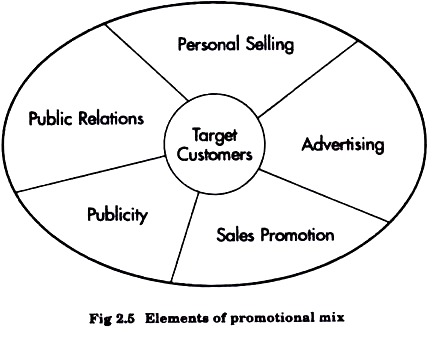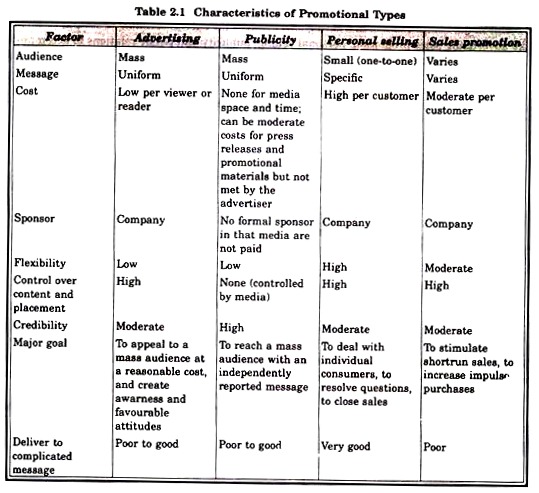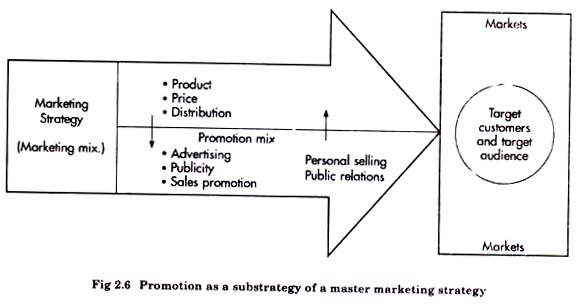This article throws light upon the top five elements of promotional mix of products. The elements are: 1. Advertising 2. Personal Selling 3. Sales Promotion 4. Publicity 5. Public Relations.
Element # 1. Advertising:
It is a paid form of non-personal mass communication by an identified sponsor. The mass media used include print media, direct mail, audio visual media, bill boards etc. Sponsors may be non-profit organization, a political candidate, a company or an individual. Advertising in used when sponsors want to communicate with a number of people who cannot be reached economically and effectively through personal means.
Merits:
1. Can reach many consumers simultaneously
2. Relatively low cost per exposure.
3. Excellent for creating brand images.
4. High degree of flexibility and variety of media to choose from;
5. Can accomplish many different types of promotion objectives.
Demerits:
1. Many consumers reached are not potential buyers (waste of promotion money)
2. High visibility makes advertising a major target of marketing critics.
3. Advertising exposure time in usually brief
4. Advertisements are often quickly and easily screened out by consumers.
Element # 2. Personal Selling:
Personal selling is face to face contact between a sellers representative and those people with whom the seller wants to communicate. Non-profit organization, political candidates, firms and individuals use personal selling to communicate with the public.
Merits:
a. Can be the most persuasive promotion tool; sales people can directly influence purchase behaviours.
b. Allows two way communication.
c. Often necessary for technically complex products.
d. Allows direct one-on-one targeting of promotional effort.
Demerits:
a. High cost per contact.
b. Sales training and motivation can be expensive and difficult.
c. Personal selling often has a poor image making sales force recruitment difficult.
d. Poorly done sales presentations can hurt sales’ as well as company, product and brand images.
Element # 3. Sales Promotion:
Sales promotion includes activities that seek to directly induce or indirectly serve as incentives to motivate, a desired response on the part of the target customers company sales people and middle men and their sales force. These activities add value to the product. In sales promotion the activities like discounts, gifts, contests, premiums, displays and coupons are included.
Some types of Sales Promotion:
1. Specially ads imprinted novelties, calendars, match boxes, souvenirs etc.) and business gifts.
2. Temporary price reductions via coupons, extended, interest free or low interest credit-refunds. rebates: price off deals, combination offers; bonus packs, multiple packs; other methods.
3. Promotions designed to get trials, such as coupons, refunds, rebates, price off deals, bonus packs. Samples, offers, trial sizes, free trials, special guarantees, premium, self liquidating premiums, reusable containers, and souvenirs.
4. Business, industrial, trades and magazines and technical papers; Journals, publications.
5. Directories and buyers guides.
6. Trading stamps redemption coupons, divided coupons and continuity premiums.
7. When held for a firm’s, sales people middle men, or customers. Meetings, sessions, seminars, symposium, conferences, conventions, show rooms, classes, fashion shows, demonstrations, taste tests and exhibits.
8. When held for a number of competing vendors, trade shows, world fairs, state fairs, county fairs, fairs, shows, conventions, exhibitions, conferences, seminars, meetings.
9. Displays, point of purchase, show windows, and in store signs and banners.
10. Catalogs, book lets, brochures, bulletins, post card, price lists, flyers/handouts, package inserts, manuals, folders, suffers, pamphlets, books, house organs, house magazines, news letters, histories, instruction sheets, instruction books annual reports, and any printed material that described the product or gives product information for the purpose of selling, training, installing, using and/or servicing.
11. Direct mail and some of the items listed above, when used for direct mail.
12. Sponsorship special events and charity linked sales promotions.
Merits:
a. Excellent approach for short term price reductions for stimulating demand.
b. A large variety of sales promotion tools to choose from.
c. Can be effective for changing a variety of consumer behaviours.
d. Can be easily tied in with other promotional tools.
Demerits:
a. May influence primarily brand-loyal customers to stock up at lower price but attract few new customers.
b. May have only short term impact.
c. Over use of price related sales promotion tools may hurt brand image and profits.
d. Effective sales promotions are easily copied by competitors.
Element # 4. Publicity:
Publicity is news carried in the mass media about a firm and its products, policies, personnel or actions. The unique feature about the publicity is that it is a non paid form of promotion, organizations frequently provide the material for publicity in the form of news, releases, photographs and press conferences.
Merits:
a. As “free advertising”, publicity can be positive and stimulate demand at no cost.
b. May be perceived by consumers as more credible, because it not paid for by the seller.
c. Consumers may pay more attention to these messages, because they are not quickly screened out as are many advertisements.
Demerits:
a. Publicity is not always possible because it is not in the hand of the seller.
b. Limited repetition of publicity messages: seldom a long.
c. Term promotion tool for brands.
d. Publicity can be negative and hurt sales as well as company product, and brand images.
e. Company cannot completely control the content of publicity messages.
Element # 5. Public Relations:
Most firms in today’s environment are also concerned about the effect of their actions on people outside their target markets although it may include them. It is a planned effort by an organization to influence the attitudes and opinions of a specific group by developing a long term relationship. The target may be customers, stock holders, a government agency or a special interest group.
Advertising and sales promotion supplement each other’s effort.





